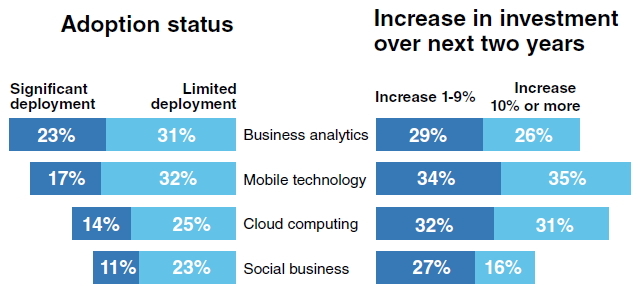Four key IT technologies that will shape the future
By Korea HeraldPublished : Jan. 30, 2013 - 20:30

Cloud computing, business analytics, mobile, social business. There is no mystery why we are hearing so much about these technologies. They are completely reshaping how business gets done and rewriting strategic playbooks across industries. In these spaces, new business possibilities are emerging and some companies are equipped to innovate at the forefront of these fast-moving technology trends and drive strategic advantages for their organizations.
In fact, CEOs say that during the next three to five years, these advanced technologies will be more important in driving change within their companies than any other issue. More so, in fact, than the globalized economy or even traditional market forces.
But here is the problem. Only one in 10 organizations surveyed worldwide in IBM’s recent Tech Trends report felt they had the skills needed to drive innovation and growth in these four critical technologies.
Simply put, we are facing an IT skills shortage. Within each of the key emerging technology areas ― mobile computing, business analytics, social business, and cloud computing ― roughly one-quarter of the companies we spoke with reported a major skills gap, while another 40 percent were experiencing a moderate skills gap.


This is a problem when 70 percent of the businesses we spoke to said they planned to increase their spending on mobile, more than half said that they planned to invest heavily in business analytics during the next two years, and two-thirds of respondents were expanding investment in cloud computing. Additionally, nearly half of those surveyed for the IBM Tech Trends report planned to increase investment in social business tools. When these findings are analyzed, the probability of an ever-widening skills void is cause for concern.
The Tech Trends report also found that the skills gap may not be narrowing over time. Seventy-three percent of students and educators surveyed believed there to be a moderate to major technical skills gap, and nearly half of the educators and students surveyed indicated major gaps in their institutions ability to meet IT skill needs in mobile, social, cloud and analytics.
The bottom line? The impact of these emerging technologies is already outpacing current skills levels. Perhaps these results are not as surprising as they appear at first glance, given the rapid pace of technological change. Just think about how in five short years, smartphones have completely reset consumer, employee and partner expectations for how companies operate, communicate and innovate.
With technology-driven innovation occurring at such a rapid pace, business, government and academia have to get serious about confronting the growing skills shortage. Students must be more proactive about developing skills, IT administrators need to fiercely support training and experimentation, and businesses must take a leadership role by offering initiatives to help people get the skills they need. More importantly, businesses need to invest more in these four areas to be more competitive and survive the fierce battles of the fast-evolving business and technological landscape.
Closing the technical skills gap requires public and private partnerships; it is not something one organization can address in isolation. To help slow and eliminate the skills gap, IBM recently announced new global skill-building initiatives in key technology areas. Many of these new initiatives include partnerships with other organizations in the public, private and academic sectors to ensure that students, professionals and educators have access to cutting-edge skill-building resources.
Businesses can also learn from industry pacesetters. IBM is using its leadership position to create the best practices that can serve as guidelines for others to learn from.
According to the Tech Trends report, about 20 percent of companies are technology pacesetters. As a group, pacesetters are more market-driven, analytical and experimental. Practically, that means these organizations are ahead of their competition in distributing insights gleaned from data to employees throughout an organization. They use social media not just to reach out to customers, but to encourage employees to connect and share expertise with each other. Pacesetters are also six to seven times more likely to use new cloud-computing concepts.
What sets pacesetters apart from the rest of the pack? Rather than wait until there’s business demand for new IT skills, they build skills ahead of time. Pacesetters are nine times more likely to experiment with emerging technologies that do not yet have a clear business application. They are also twice as likely to proactively develop skills to meet anticipated needs. But being experimental doesn’t equal being careless. Across all four technologies, pacesetters are more likely than other companies to have adequate security policies in place.
When it comes to lessons for closing the skills gap, pacesetters are encouraging the growth of further expertise among their employees across a range of disciplines, not just in specific silos. For instance, they are combining areas of expertise, such as technology and business analytics. They sponsor “sandboxes,” allowing for experimentation with new technologies or encouraging crowd source innovation. Pacesetters treat security as a business imperative, because security concerns often prevent the adoption of emerging technology.
Innovation is occurring faster than many of us can keep up with. Luckily, by watching the pacesetters and building upon their lessons of success, we can stay on the technology fast track.
By Nam Jeong-tae
The author currently serves as chief technology officer at IBM Korea. ― Ed.
In fact, CEOs say that during the next three to five years, these advanced technologies will be more important in driving change within their companies than any other issue. More so, in fact, than the globalized economy or even traditional market forces.
But here is the problem. Only one in 10 organizations surveyed worldwide in IBM’s recent Tech Trends report felt they had the skills needed to drive innovation and growth in these four critical technologies.
Simply put, we are facing an IT skills shortage. Within each of the key emerging technology areas ― mobile computing, business analytics, social business, and cloud computing ― roughly one-quarter of the companies we spoke with reported a major skills gap, while another 40 percent were experiencing a moderate skills gap.


This is a problem when 70 percent of the businesses we spoke to said they planned to increase their spending on mobile, more than half said that they planned to invest heavily in business analytics during the next two years, and two-thirds of respondents were expanding investment in cloud computing. Additionally, nearly half of those surveyed for the IBM Tech Trends report planned to increase investment in social business tools. When these findings are analyzed, the probability of an ever-widening skills void is cause for concern.
The Tech Trends report also found that the skills gap may not be narrowing over time. Seventy-three percent of students and educators surveyed believed there to be a moderate to major technical skills gap, and nearly half of the educators and students surveyed indicated major gaps in their institutions ability to meet IT skill needs in mobile, social, cloud and analytics.
The bottom line? The impact of these emerging technologies is already outpacing current skills levels. Perhaps these results are not as surprising as they appear at first glance, given the rapid pace of technological change. Just think about how in five short years, smartphones have completely reset consumer, employee and partner expectations for how companies operate, communicate and innovate.
With technology-driven innovation occurring at such a rapid pace, business, government and academia have to get serious about confronting the growing skills shortage. Students must be more proactive about developing skills, IT administrators need to fiercely support training and experimentation, and businesses must take a leadership role by offering initiatives to help people get the skills they need. More importantly, businesses need to invest more in these four areas to be more competitive and survive the fierce battles of the fast-evolving business and technological landscape.
Closing the technical skills gap requires public and private partnerships; it is not something one organization can address in isolation. To help slow and eliminate the skills gap, IBM recently announced new global skill-building initiatives in key technology areas. Many of these new initiatives include partnerships with other organizations in the public, private and academic sectors to ensure that students, professionals and educators have access to cutting-edge skill-building resources.
Businesses can also learn from industry pacesetters. IBM is using its leadership position to create the best practices that can serve as guidelines for others to learn from.
According to the Tech Trends report, about 20 percent of companies are technology pacesetters. As a group, pacesetters are more market-driven, analytical and experimental. Practically, that means these organizations are ahead of their competition in distributing insights gleaned from data to employees throughout an organization. They use social media not just to reach out to customers, but to encourage employees to connect and share expertise with each other. Pacesetters are also six to seven times more likely to use new cloud-computing concepts.
What sets pacesetters apart from the rest of the pack? Rather than wait until there’s business demand for new IT skills, they build skills ahead of time. Pacesetters are nine times more likely to experiment with emerging technologies that do not yet have a clear business application. They are also twice as likely to proactively develop skills to meet anticipated needs. But being experimental doesn’t equal being careless. Across all four technologies, pacesetters are more likely than other companies to have adequate security policies in place.
When it comes to lessons for closing the skills gap, pacesetters are encouraging the growth of further expertise among their employees across a range of disciplines, not just in specific silos. For instance, they are combining areas of expertise, such as technology and business analytics. They sponsor “sandboxes,” allowing for experimentation with new technologies or encouraging crowd source innovation. Pacesetters treat security as a business imperative, because security concerns often prevent the adoption of emerging technology.
Innovation is occurring faster than many of us can keep up with. Luckily, by watching the pacesetters and building upon their lessons of success, we can stay on the technology fast track.
By Nam Jeong-tae
The author currently serves as chief technology officer at IBM Korea. ― Ed.
-
Articles by Korea Herald




![[Graphic News] Number of coffee franchises in S. Korea rises 13%](http://res.heraldm.com/phpwas/restmb_idxmake.php?idx=644&simg=/content/image/2024/05/02/20240502050817_0.gif&u=)



![[Robert J. Fouser] AI changes rationale for learning languages](http://res.heraldm.com/phpwas/restmb_idxmake.php?idx=644&simg=/content/image/2024/05/02/20240502050811_0.jpg&u=)









![[Eye Interview] 'If you live to 100, you might as well be happy,' says 88-year-old bestselling essayist](http://res.heraldm.com/phpwas/restmb_idxmake.php?idx=652&simg=/content/image/2024/05/03/20240503050674_0.jpg&u=)
